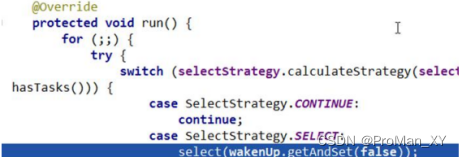指南
在 io.netty.example 包下,有很多Netty源码案例,比较适合分析
Netty启动过程源码剖析
- 源码需要剖析到Netty调用doBind(),追踪到NioServerSocketChannel的doBind()。
- 并且要Debug程序到NioEventLoop类的run(),无限循环,在服务器端运行。

demo 源码EchoServer类的基本理解
** Copyright 2012 The Netty Project** The Netty Project licenses this file to you under the Apache License,* version 2.0 (the "License"); you may not use this file except in compliance* with the License. You may obtain a copy of the License at:** http://www.apache.org/licenses/LICENSE-2.0** Unless required by applicable law or agreed to in writing, software* distributed under the License is distributed on an "AS IS" BASIS, WITHOUT* WARRANTIES OR CONDITIONS OF ANY KIND, either express or implied. See the* License for the specific language governing permissions and limitations* under the License.*/
package com.guokai.netty.source.echo;import io.netty.bootstrap.ServerBootstrap;
import io.netty.channel.ChannelFuture;
import io.netty.channel.ChannelInitializer;
import io.netty.channel.ChannelOption;
import io.netty.channel.ChannelPipeline;
import io.netty.channel.EventLoopGroup;
import io.netty.channel.nio.NioEventLoopGroup;
import io.netty.channel.socket.SocketChannel;
import io.netty.channel.socket.nio.NioServerSocketChannel;
import io.netty.handler.logging.LogLevel;
import io.netty.handler.logging.LoggingHandler;
import io.netty.handler.ssl.SslContext;
import io.netty.handler.ssl.SslContextBuilder;
import io.netty.handler.ssl.util.SelfSignedCertificate;/*** Echoes back any received data from a client.*/
public final class EchoServer {static final boolean SSL = System.getProperty("ssl") != null;static final int PORT = Integer.parseInt(System.getProperty("port", "8007"));public static void main(String[] args) throws Exception {// Configure SSL.final SslContext sslCtx;if (SSL) {SelfSignedCertificate ssc = new SelfSignedCertificate();sslCtx = SslContextBuilder.forServer(ssc.certificate(), ssc.privateKey()).build();} else {sslCtx = null;}// Configure the server.EventLoopGroup bossGroup = new NioEventLoopGroup(1);EventLoopGroup workerGroup = new NioEventLoopGroup();try {ServerBootstrap b = new ServerBootstrap();b.group(bossGroup, workerGroup).channel(NioServerSocketChannel.class).option(ChannelOption.SO_BACKLOG, 100).handler(new LoggingHandler(LogLevel.INFO)).childHandler(new ChannelInitializer<SocketChannel>() {@Overridepublic void initChannel(SocketChannel ch) throws Exception {ChannelPipeline p = ch.pipeline();if (sslCtx != null) {p.addLast(sslCtx.newHandler(ch.alloc()));}//p.addLast(new LoggingHandler(LogLevel.INFO));p.addLast(new EchoServerHandler());}});// Start the server.ChannelFuture f = b.bind(PORT).sync();// Wait until the server socket is closed.f.channel().closeFuture().sync();} finally {// Shut down all event loops to terminate all threads.bossGroup.shutdownGracefully();workerGroup.shutdownGracefully();}}
}说明:
- 先看启动类: main 方法中,首先创建了关于 SSL 的配置类。
- 重点分析下创建了两个 EventLoopGroup 对象:
- EventloopGroup bossGroup = new NioEventl.oopGroup(1).
- EventLoopGroup workerGroup = new NioEventloopGroup( ).
- 这两个对象是整个Netty的核心对象,可以说整个Netty的运作都依赖于他们。bossGroup 用于接受Tcp 请求,他会将请求交给 wokerGroup ,workerGroup 会获取到真正的连接,然后和连接进行通信,比如读写解码编码等操作。
- EventLoopGroup是事件循环组(线程组) 有多个 EventLoop,可以注册 channel ,用于在事件循环中去进行选择(和选择器相关)。[debug 看]
- new NioEventLoopGroup(l); 这个 1 表示 bossGroup 事件组有 1 个线程你可以指定,如果 newNioEventLoopGroup()会含有默认线程个数为(cpu 核数*2),即可以充分的利用多核的优势,[可以 dubug 一把]
- DEFAULT_EVENT_LOOP_THREADS = Math.max(1, SystemPropertyUtil.getInt("io.netty.eventLoopThreads",NettyRuntime.availableProcessors() * 2));
-
会创建 EventExecutor 数组 children =new EventExecutor(nThreads];//debug -下
- 每个元素的类型就是 NIOEventLoop, NIOEventLoop实现了EventLoop接口和Executor 接口
- Try块中创建了一个ServerBootstrap对象,他是一个引导类,用于启动服务器和引导整个程序的初始化(看下源try码 allows easy bootstrap of{@link ServerChannel} ) 。它和 ServerChannel 关联,而 ServerChannel 继承了Channel,有一些方法 remoteAddress 等[可以Debug 下]
-
随后,变量 b 调用了 group 方法将两个 group 放入了自己的字段中,用于后期引导使用[debug 下 group 方法】
- 然后添加了一个 channel,其中参数一个 Class 对象,引导类将通过这个 Class 对象反射创建ChannelFactory。然后添加了一些 TCP 的参数。[说明: Channel 的创建在 bind 方法,可以 Debug 下 bind ,会找到 channel = channelFactory.newChannel(); ]
- 再添加了一个服务器专属的日志处理器 handler。
- 再添加一个 SocketChannel (不是 ServerSocketChannel) 的 handler。
- 然后绑定端口并阻塞至连接成功。
- 最后 main 线程阻塞等待关闭。
-
finally 块中的代码将在服务器关闭时优雅关闭所有资源







》相关算法代码及其分析(3))









)

